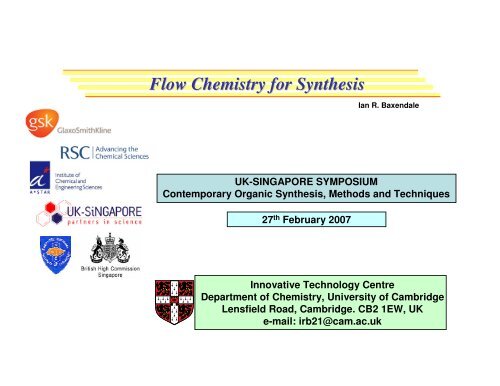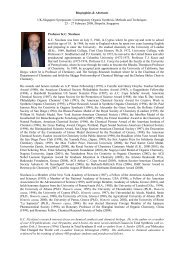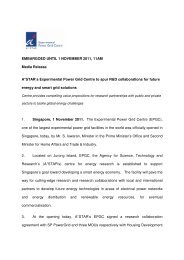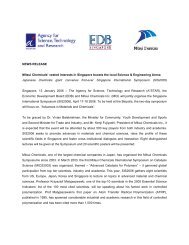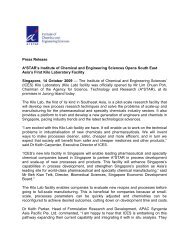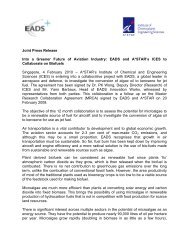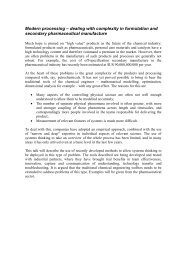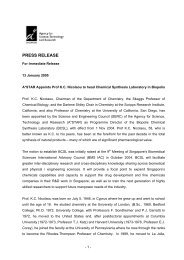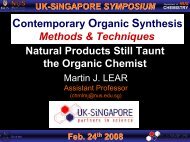Create successful ePaper yourself
Turn your PDF publications into a flip-book with our unique Google optimized e-Paper software.
<strong>Flow</strong> <strong>Chemistry</strong> <strong>for</strong> <strong>Synthesis</strong><br />
Ian R. Baxendale<br />
UK-SINGAPORE SYMPOSIUM<br />
Contemporary Organic <strong>Synthesis</strong>, Methods and Techniques<br />
27 th February 2007<br />
Innovative Technology Centre<br />
Department of <strong>Chemistry</strong>, University of Cambridge<br />
Lensfield Road, Cambridge. CB2 1EW, UK<br />
e-mail: irb21@cam.ac.uk
Benefits of <strong>Flow</strong> <strong>Synthesis</strong> – a few comments<br />
– Its ‘new’ and very few people know what it is.<br />
Will it solve the problem? What is the problem?<br />
– Increased reaction rates relative to batch chemistry?<br />
Diffusion, convection, mass transport – size does matter!<br />
– Ability to use superheated, pressurised solvents.<br />
Access to new chemical domains, rapid heat/cool. Analogous to MW?<br />
– Generation and use of unstable/hazardous reaction intermediates.<br />
Safety aspect to the small active volumes used.<br />
– Automation – 24/7 working?<br />
What's the chemists time then used <strong>for</strong>?<br />
– Possible in-line analysis, optimisation and purification.<br />
Faster concept to product translation.<br />
– Several steps may be carried out in sequence.<br />
Steps are no longer the classical conversion of A to B.
Solid Supported Reagents : <strong>Synthesis</strong> of Sildenafil<br />
11 steps (8 longest linear)<br />
8 immobilised reagents<br />
58% overall yield<br />
no aqueous workup<br />
no column chromatography<br />
analytically pure<br />
I.R. Baxendale, S.V. Ley et al. Bioorg. Med. Chem. Lett. 2000, 10, 1983.
Basic <strong>Flow</strong> Reactor Configuration<br />
Solvent<br />
wash<br />
Loading<br />
sequence<br />
Loading step<br />
Solvent<br />
Reactant<br />
wash<br />
R<br />
R<br />
Reaction Loading Loaded<br />
Loading sequence step<br />
Product to waste<br />
>90 yield (>95% purity)
<strong>Flow</strong> <strong>Synthesis</strong> of Dipeptides<br />
Loading step<br />
Waste<br />
Isolated yields: 50-250 mg of product<br />
Boc–Ala–Phe–OEt<br />
Boc–Ala–Gly–OEt<br />
Boc–Ala–Val–OMe<br />
Boc–Ala–Pro–OMe<br />
80%<br />
81%<br />
83%<br />
66%<br />
Cbz–Ala–Val–OMe<br />
Cbz–Ala–Gly–OEt<br />
Cbz–Ala–Phe–OEt<br />
Cbz–Ala–Gly–OEt<br />
Cbz–Ala–Pro–OMe<br />
79%<br />
76%<br />
75%<br />
78%<br />
61%
<strong>Flow</strong> <strong>Synthesis</strong> of Peptides<br />
<strong>Flow</strong> stream 1 <strong>Flow</strong> stream 2<br />
H-Cube<br />
Waste<br />
Waste<br />
<strong>Flow</strong> Cbz deprotection<br />
10% Pd/C, 60 o C, 1 mL/min<br />
Cbz–Phe–Ala–Gly–OEt<br />
59% isolated yield<br />
I.R. Baxendale, S.V. Ley et al. Chem. Commun. 2006, 4835.
Hydrogenation in <strong>Flow</strong><br />
System pressure<br />
sensor<br />
‘Bubble’ sensor<br />
T-piece mixer<br />
OUT<br />
IN<br />
H 2 O<br />
R 3<br />
N<br />
R 1 R 2<br />
electrolysis<br />
H 2 (g)<br />
R 3<br />
HN<br />
R 1 R 2<br />
Yield (Purity)<br />
Backpressure<br />
regulator<br />
Cartridge holder<br />
Heater unit<br />
H 2<br />
inlet from<br />
electrolytic cell<br />
Inlet pressure<br />
sensor<br />
Quant. (95%)<br />
Quant. (90%)<br />
99% (>95%)<br />
Quant. (>95%)<br />
Quant. (84%)<br />
Quant. (>95%)<br />
Quant. (90%)<br />
99% (>95%)<br />
96% (85%)<br />
Quant. (90%)<br />
84% (88%)<br />
Quant. (92%)<br />
Quant. (95%)<br />
Quant. (95%)<br />
S.V. Ley et al. Chem. Commun. 2005, 2909 & Synlett 2006, 6, 889 & Adv. Synth. Catal. 2007, 349, 535.
<strong>Synthesis</strong> of Riboflavin analogues and Benzimidazoles<br />
H<br />
Starting materials<br />
90% 89%<br />
88% 84%<br />
>85% isolated yield
loading step<br />
<strong>Synthesis</strong> of Grossamide<br />
Second input stream<br />
H 2 O 2 –urea complex<br />
Acetone / H 2 O (10:1)<br />
DMF THF<br />
Enzyme<br />
Grossamide<br />
Column<br />
Container<br />
1 PS-HOBt 1 Ferulic acid<br />
2 PS-HOBt 2 PyBrOP, DIPEA<br />
3 PS-SO 3<br />
H 3 Amine solution<br />
4 Enzyme 4 Washings<br />
5 H 2<br />
O 2<br />
urea complex Buffer pH 4.5<br />
I.R. Baxendale, S.V. Ley et al. Synlett 2006, 427.
<strong>Flow</strong> <strong>Synthesis</strong> of Oxomaritidine<br />
MeCN:THF (1:1)<br />
70 o C<br />
55 rt o C<br />
To waste<br />
THF<br />
rt<br />
<strong>Flow</strong><br />
Hydrogenation<br />
10% Pd/C, THF<br />
H-Cube<br />
80 o C<br />
DCM<br />
MeOH:H 2<br />
O (4:1)<br />
DCM<br />
35 o C<br />
I.R. Baxendale, S.V. Ley et al. Chem. Comm. 2006, 2566.
<strong>Flow</strong> Synthesizer Equipment
<strong>Synthesis</strong> of Oxazoles in <strong>Flow</strong><br />
9 Oxazole 36 Oxazoles preparations structures scaled prepared to >10g<br />
I.R. Baxendale, S.V. Ley et al. Org. Lett. 2006, 8, 5231
<strong>Flow</strong> <strong>Synthesis</strong> of Thiazoles<br />
Using DCM<br />
as the solvent<br />
R= NO 2<br />
90%<br />
2-OMe 89%<br />
4-OMe 96%<br />
3-F 68%<br />
4-Cl 48%<br />
4-Br 53%<br />
90%<br />
25-55 o C<br />
MeCN<br />
Scaled up to 12 g<br />
50-96%<br />
20-50%<br />
85%<br />
88%<br />
84%<br />
90%<br />
89% 85%<br />
12:5 89% 4:5 94% 2:1 86%<br />
Cu TC complex<br />
I.R. Baxendale, S.V. Ley et al. unpublished results
Azide coupling in <strong>Flow</strong><br />
QP-TU<br />
Purities greater than 95%<br />
89%<br />
95%<br />
91%<br />
90%<br />
98%<br />
82%<br />
91%<br />
89%<br />
96%<br />
94%<br />
93%<br />
85%<br />
81%<br />
87%<br />
88%<br />
88%<br />
70%<br />
93%<br />
85%<br />
I.R. Baxendale, S.V. Ley et al. Org. Biomol. Chem. 2007, 5, 1559.
Curtius-Rearrangements in <strong>Flow</strong><br />
1.1 equiv.<br />
1.25-5 equiv.<br />
3 equiv.<br />
1-2 mmol scale<br />
30-60 min reaction time<br />
Elute to waste<br />
1.0 equiv.<br />
Catch product<br />
NH 3<br />
/MeOH<br />
Vapourtec R4/R2+<br />
I.R. Baxendale, S.V. Ley et al. Org. Biomol. Chem. 2008, Special Issue.
Polymeric Monoliths<br />
• 15 ×100 mm Omnifit column<br />
• 0.5 mmol<br />
• ×6 regeneration<br />
• Loading >5 mmol<br />
VBC DVB 1-Dodecanol Toluene AIBN Temperature<br />
35% 20% 40% 5% 1% 80 o C
Curtius-Rearrangements in <strong>Flow</strong> Using Azide Monoliths<br />
150 mm<br />
15 mm<br />
I.R. Baxendale, S.V. Ley et al. Org. Biomol. Chem. 2008, Special Issue.<br />
15-18 mmol N 3
Tagged Substrates in <strong>Flow</strong><br />
<strong>Chemistry</strong><br />
Tag Sub + Regt<br />
Tag Prod + Regt<br />
Selective<br />
sequestration<br />
Regt<br />
Wash to waste<br />
Tag<br />
Prod<br />
Release<br />
Tag<br />
Prod<br />
0 o C<br />
THF<br />
plus by-products<br />
Wash by-products<br />
to waste<br />
64% 70% 72%<br />
I.R. Baxendale, S.V. Ley et al. Org. Biomol. Chem. 2005, 3, 3140.
Sub<br />
+<br />
Tag<br />
Regt<br />
<strong>Chemistry</strong><br />
Prod<br />
+<br />
Tag<br />
Regt<br />
Selective<br />
sequestration<br />
Prod<br />
Tagged Reagents in <strong>Flow</strong><br />
Tag<br />
Regt<br />
Crude<br />
Product<br />
Pure product<br />
81% 59% 85%<br />
90% 88% 90%<br />
77% 79% 82% 1 mmol 10 min<br />
I.R. Baxendale and S.V. Ley et al. unpublished results.
Tagged Reagents in <strong>Flow</strong><br />
1 equiv. 0.5 equiv.<br />
MeCN 110 o C<br />
0.85 equiv.<br />
Vapourtec V10<br />
SiO 2<br />
1) Evaporate<br />
2) TFA/TMS-H DCM<br />
3) Evaporate<br />
4) DCM/MeOH<br />
73%<br />
R = 4-Br 85%<br />
3,4-Cl 84%<br />
2-OMe 73%<br />
4-OMe 82%<br />
84%<br />
59%<br />
77%<br />
79%<br />
65%<br />
78%<br />
75%<br />
81%<br />
74%<br />
83%<br />
I.R. Baxendale, S.V. Ley et al. Org. Biomol. Chem. 2007, 5, 1562.
Intramolecular Cycloaddition Reaction<br />
15 hours<br />
62% isolated<br />
15 hours<br />
1 hour<br />
39% isolated<br />
81% isolated<br />
6 hours<br />
1 hour<br />
87% isolated<br />
48% isolated<br />
1 hour<br />
1 hour<br />
80% isolated<br />
78% isolated<br />
28 hours<br />
1 hour<br />
78% isolated<br />
53% isolated<br />
I.R. Baxendale, S.V. Ley et al. Org. Biomol. Chem. 2005, 3, 3365.<br />
0.2 -<br />
0.5 ml<br />
0.5 -<br />
2 ml<br />
2 -<br />
5 ml<br />
10-20 ml
Catalyst<br />
Pd EnCat<br />
<strong>Flow</strong> Suzuki Reactions using Pd EnCat<br />
Pd = Pd(OAc) 2<br />
Pd<br />
Pd<br />
Pd<br />
Microwaved<br />
region<br />
Pd<br />
Pd<br />
Pd<br />
Pd<br />
Inert packing<br />
material<br />
Starting<br />
materials<br />
Scavenging<br />
cartridge<br />
Product out
Sequential <strong>Flow</strong> Microwave Heating<br />
Rxn<br />
No.<br />
Boronic acid<br />
Halide<br />
Purity (Yield)<br />
Batch <strong>Flow</strong><br />
1<br />
88% (>98) 90% (>98)<br />
<strong>Flow</strong><br />
Purity (Yield)<br />
>98(87)<br />
Batch<br />
Purity (Yield)<br />
>98(92)<br />
2<br />
3<br />
84% (82) 87% (>98)<br />
94% (64) 94% (>98)<br />
>98(92)<br />
>98(89)<br />
4<br />
94% (54) 92% (92)<br />
5<br />
77% (40) 88% (94)<br />
>98(88)<br />
>98(91)<br />
6<br />
99% (30) 97% (91)<br />
>98(81)<br />
>98(72)<br />
7<br />
72% (26) 76% (>98)<br />
2 equiv. Bu 4<br />
NOAc, EtOH, 0.07 M, 0.1 ml/min,<br />
pulsed heating (30s @ 50W, 15s Cooling)<br />
Residence time ~ 2 min<br />
8<br />
9<br />
82% (23) 89% (>98)<br />
92% (19) 94% (91)<br />
10<br />
81% (
<strong>Flow</strong> Microwave Heating<br />
172 mg Catalyst = 0.069 mmol<br />
0.1 M solution flowed at 0.2 ml/min<br />
Heating at 50W with compressed air cooling<br />
28 hours of reaction.<br />
33.6 mmol product (7.53 g) Ξ 0.2 mol% cat<br />
182 mg Catalyst = 0.073 mmol<br />
0.1 M solution flowed at 0.2 ml/min<br />
Heating at 50W with compressed air cooling<br />
34 hours of reaction.<br />
40.8 mmol product (9.34 g) Ξ 0.2 mol% cat<br />
I.R. Baxendale, S.V. Ley et al. Chem. Eur. J. 2006, 12, 4407.
<strong>Synthesis</strong> of Pyrazoles Dimers<br />
MeOH<br />
Activated<br />
Carbon<br />
25 mol%<br />
t<br />
BuOK<br />
MW 165 o C<br />
toluene, 1-2 hr<br />
MW 100 o C<br />
2-10 min<br />
Vapourtec V-10<br />
88-95%<br />
isolated yield<br />
Activated<br />
carbon<br />
Amine<br />
scavenger<br />
I.R. Baxendale, S.V. Ley et al. Org. Biomol. Chem. 2007, 5, 2758.<br />
50-65% isolated yield
Microcapillary Reactor<br />
The films possess<br />
useful optical and<br />
thermal properties<br />
I.R. Baxendale, S.V. Ley et al. OPRD 2007, 11, 399.
Microcapillary Reactor<br />
55 o C<br />
32 o C<br />
25 cm<br />
single spiral<br />
double spiral<br />
I.R. Baxendale, S.V. Ley et al. OPRD 2007, 11, 399.
MFD Reactor<br />
98% isolated yield; 4 ml/min<br />
output 0.37 g/min or 0.526 kg/day<br />
93 % conversion (98% isolated yields)<br />
6 ml/min; output of 2.73 g/min or 3.93 kg/day<br />
I.R. Baxendale, S.V. Ley et al. OPRD 2007, 11, 399.
Scale-up <strong>Synthesis</strong> in <strong>Flow</strong><br />
60 L 56.63 moles<br />
1.2 equiv. Conc: 0.94 M<br />
30 L 47.19 moles<br />
Conc: 1.57 M<br />
NaS 2<br />
O 3<br />
/NaOH 1.5 M<br />
30 L 51.91 moles<br />
1.1 equiv. Conc: 1.73 M<br />
Exotherm<br />
Regulated
Scale-up <strong>Synthesis</strong> in <strong>Flow</strong><br />
<strong>Flow</strong> Rate 3 0.5 mL/min<br />
mL/min<br />
<strong>Flow</strong> Rate 0.25 3.25 1.5 mL/min<br />
60 L 56.63 moles<br />
1.2 equiv. Conc: 0.94 M<br />
<strong>Flow</strong> Rate 1.5 mL/min<br />
30 L 47.19 moles<br />
Conc: 1.43 M<br />
10% NaS 2<br />
O 3<br />
/NaOH 1.5 M.<br />
30 L 51.91 moles<br />
1.1 equiv. Conc: 1.57 M<br />
<strong>Flow</strong> Rate 3.25 mL/min<br />
<strong>Flow</strong> Rate 0.25 1.5 mL/min<br />
Exotherm<br />
Regulated
Scale-out <strong>Synthesis</strong> in <strong>Flow</strong><br />
NaS 2<br />
O 3<br />
/NaOH 1M<br />
3 mL/min per channel<br />
1.5 mL/min<br />
waste<br />
Aqueous<br />
Organic<br />
30 L 51.91 moles<br />
1.1 equiv. Conc: 1.73 M<br />
30 L 47.19 moles<br />
Conc: 1.57 M<br />
Max 2.5 mL/min<br />
12 mL/min flow rate<br />
Increase residence time<br />
60 L 56.63 moles<br />
1.2 equiv. Conc: 0.94 M<br />
2 mL/min per channel<br />
3 channels<br />
Need to split<br />
12 ways<br />
6.9 days processing<br />
120 L of reaction solution<br />
11.5 kg 95%
Innovative Technology Centre<br />
Department of <strong>Chemistry</strong><br />
University of Cambridge<br />
irb21@cam.ac.uk<br />
http://leyitc.ch.cam.ac.uk<br />
Special thanks to<br />
Prof. Steven V. Ley and the ITC Team<br />
Prof. Malcolm Mackley (Chem. Eng.)<br />
We also thank the following organizations <strong>for</strong> their support and financial assistance:<br />
Advion, AstraZeneca, Biotage, CEM, EPSRC, Genapta, GlaxoSmithKline, Novartis,<br />
Pfizer, Reaxa, Syngenta, Vapourtec, Uniqsis.


